
Eucalyptus marginata, commonly known as jarrah, djarraly in Noongar language and historically as Swan River mahogany, is a plant in the myrtle family, Myrtaceae and is endemic to the south-west of Western Australia. It is a tree with rough, fibrous bark, leaves with a distinct midvein, white flowers and relatively large, more or less spherical fruit. Its hard, dense timber is insect resistant although the tree is susceptible to dieback. The timber has been utilised for cabinet-making, flooring and railway sleepers.
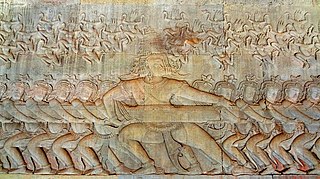
Asuras are a class of beings in Indian religions. They are described as power-seeking clans related to the more benevolent Devas in Hinduism. In its Buddhist context, the word is sometimes translated "titan, "demigod", or "antigod".

The pygmy right whale may be a member of the cetotheres, a family of baleen whales, which until 2012 were thought to be extinct; C. marginata has otherwise been considered the sole member of the family Neobalaenidae. First described by John Edward Gray in 1846, it is the smallest of the baleen whales, ranging between 6 and 6.5 metres in length and 3,000 and 3,500 kilograms in mass. Despite its name, the pygmy right whale may have more in common with the gray whale and rorquals than the bowhead and right whales.
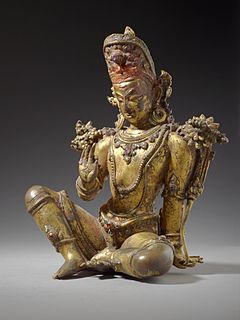
Deva means "heavenly, divine, anything of excellence", and is also one of the terms for a deity in Hinduism. Deva is a masculine term; the feminine equivalent is Devi.

The marginated tortoise is a species of tortoise in the family Testudinidae. The species is endemic to Greece, Italy, and the Balkans in Southern Europe. It is the largest European tortoise. The marginated tortoise is herbivorous, and hibernates for the winter.
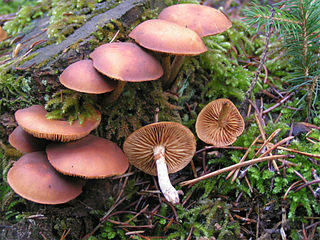
Galerina is a genus of small brown-spore saprobic mushrooms, with over 300 species found throughout the world, from the far north to remote Macquarie Island in the Southern Ocean. Species are typically small and hygrophanous, with a slender and brittle stem. They are often found growing on wood, and when on the ground have a preference for mossy habitats. This group is most noted for toxic species which are occasionally confused with hallucinogenic species of Psilocybe.

An asura in Buddhism is a demigod or titan of the Kāmadhātu. They are described as having three heads with three faces each and either four or six arms.

Banksia marginata, commonly known as the silver banksia, is a species of tree or woody shrub in the plant genus Banksia found throughout much of southeastern Australia. It ranges from the Eyre Peninsula in South Australia to north of Armidale, New South Wales, and across Tasmania and the islands of Bass Strait. It grows in various habitats, including Eucalyptus forest, scrub, heathland and moorland. Banksia marginata varies widely in habit, ranging from a 20-centimetre (7.9 in) shrub to a 12-metre (40 ft) tree. The narrow leaves are linear and the yellow inflorescences occur from late summer to early winter. The flower spikes fade to brown and then grey and develop woody follicles bearing the winged seeds. Originally described by Antonio José Cavanilles in 1800, further collections of B. marginata were designated as several separate species by Robert Brown in 1810. However, all were reclassified as a single species by George Bentham in 1870. No distinct subspecies have been recognised by Banksia expert Alex George, who nonetheless concedes that further work is needed.
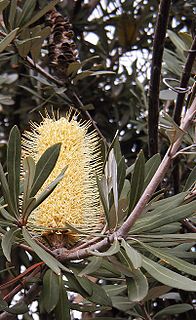
Banksia ser. Salicinae is a valid botanic name for a series of Banksia. First published by Carl Meissner in 1856, the name has had three circumscriptions.
The Field Elm cultivar Ulmus minor 'Viminalis Marginata', a variegated form of Ulmus minor 'Viminalis', was first listed as Ulmus campestris var. viminalis marginataHort. by Kirchner in 1864. Both Van Houtte and Späth marketed an U. campestris viminalis marginata in the late 19th century.
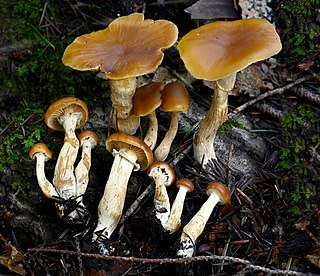
Galerina marginata, known colloquially as the funeral bell or the deadly skullcap, is a species of poisonous fungus in the family Hymenogastraceae of the order Agaricales. Prior to 2001, the species G. autumnalis, G. oregonensis, G. unicolor, and G. venenata were thought to be separate due to differences in habitat and the viscidity of their caps, but phylogenetic analysis showed that they are all the same species.

The Field Elm cultivar Ulmus minor 'Viminalis Pulverulenta' (:'powdery'), also known as 'Viminalis Variegata', a variegated form of U. minor 'Viminalis', was first mentioned by Dieck, in 1885 as U. scabra viminalis pulverulentaHort., but without description. Nursery, arboretum, and herbarium specimens confirm that this cultivar was sometimes regarded as synonymous with U. minor 'Viminalis Marginata', first listed in 1864, which is variegated mostly on the leaf margin. It is likely, however, that 'Pulverulenta' was the U. 'Viminalis Variegata', Variegated Twiggy-branched elm, that was listed and described by John Frederick Wood, F.H.S., in The Midland Florist and Suburban Horticulturist 1847 and 1851, pre-dating both Kirchner and Dieck. Wood did not specify the nature of the variegation.
Carl Meissner's taxonomic arrangement of Banksia was published in 1856, as part of his chapter on the Proteaceae in A. P. de Candolle's Prodromus systematis naturalis regni vegetabilis. It was the first attempt to provide an infrageneric classification for the genus, aside from Robert Brown's publication of two subgenera in 1810. Meissner's arrangement stood until 1870, when it was superseded by the arrangement of George Bentham. Meissner's arrangement was an excellent survey of the known species at that time, but his infrageneric taxa were all highly heterogeneous.

Glomeris marginata is a common European species of pill millipede. It is a short millipede, rounded in cross-section, which is capable of rolling itself up into a ball ("volvation") when disturbed. This behaviour is also found in the pill woodlouse Armadillidium, with which G. marginata is often confused.

Asura is a genus of moths in the subfamily Arctiinae erected by Francis Walker in 1854.

Asura's Wrath is an action video game developed by CyberConnect2 and published by Capcom. Asura's Wrath was first announced at the Tokyo Game Show in 2010, and was released worldwide in February 2012. The game is playable on PlayStation 3, Xbox 360, Xbox One & Xbox Series X/S via 360 backwards compatibility, and the PlayStation 4 and PC via PlayStation Now.

Persoonia marginata, commonly known as the Clandulla geebung, is a plant in the family Proteaceae and is endemic to New South Wales. It is low, spreading shrub with elliptic to egg-shaped leaves and small groups of cylindrical yellow flowers.
Asura quadrilineata is a moth of the family Erebidae. It is found on Aru and in Australia.

Cyme sexualis is a moth of the subfamily Arctiinae first described by Felder in 1864. It is found on Ambon, Sulawesi, the Dampier Archipelago. and in New Guinea.

Hakea marginata is a shrub in the family, Proteaceae and is endemic to an area in the Mid West, Wheatbelt, Peel, South West, Great Southern and Goldfields-Esperance regions of Western Australia.
















